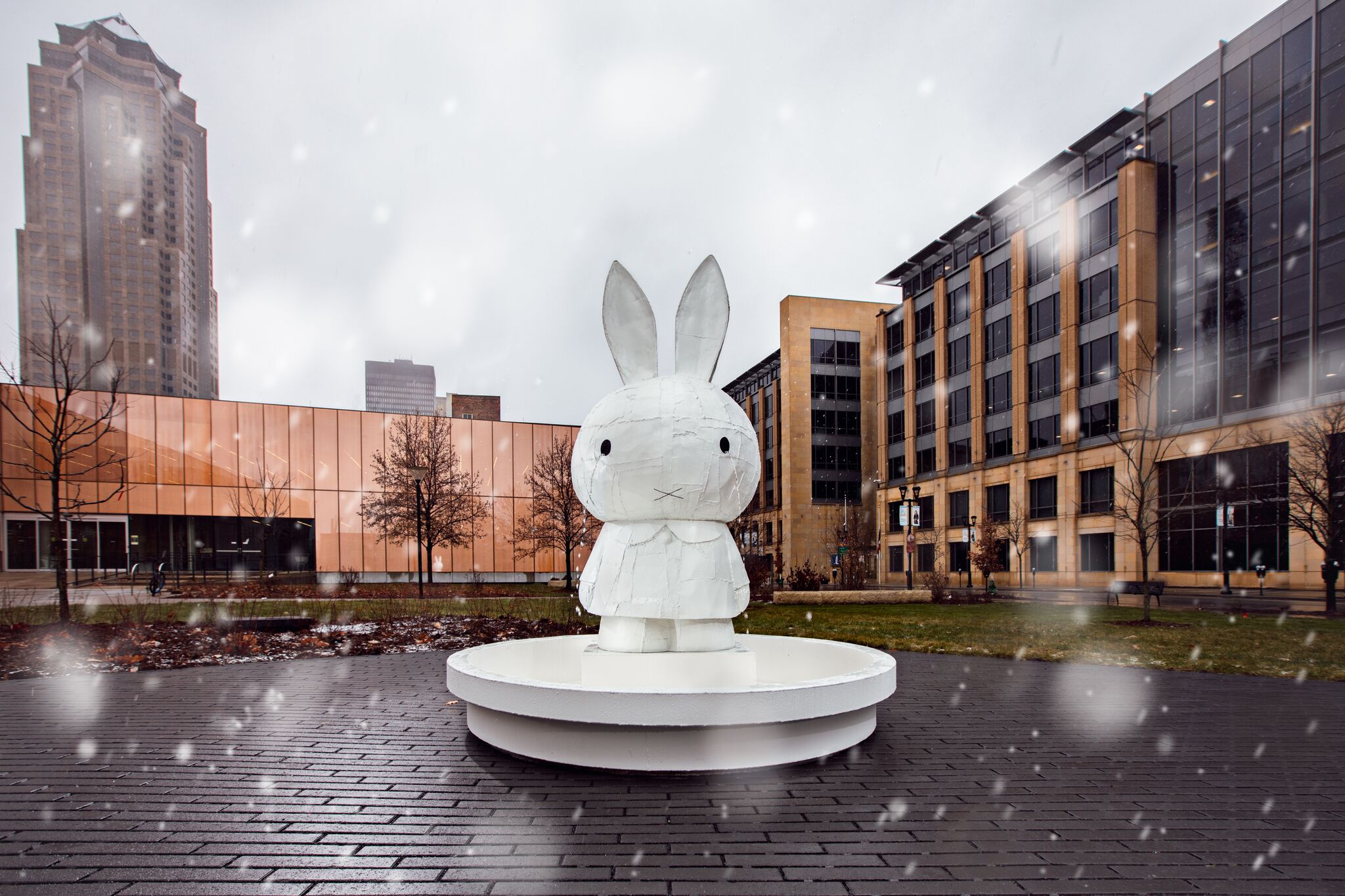


Miffy Fountain
All is flux, nothing stays still.
A Greek quotation attributed to Heraclitus: “All is flux, nothing stays still” is an appropriate way to begin to talk about Miffy Fountain.
The sight and sound of moving water is both stimulating and entrancing. Throughout history, people have attempted to shape and control this elusive element in fountains. From the beginning, fountains have been rife with symbolic connotations. Certain commonalities are inherent in the properties of water, but ways for its display have been far ranging. All cultures associate water with spiritual blessing. Over centuries and across nations, artists, architects, landscape and garden designers, hydraulics experts, and engineers have collaborated to exploit the refreshing, soothing, and theatrical potential of water—with the result that fountains grace every major city in the world.
Today, fountains are often part of urban development schemes and the shift is from scenographic displays to improvisational theater.
The artist Tom Sachs explores the fountain’s function as an icon and metaphor. Miffy Fountain (2007) is the first, long-term fountain which the artist has created. This public art project is integrated into Des Moines’ Western Gateway Park as a downtown oasis.
— M. J. Rowe
Miffy As Icon
The sculpture, Miffy Fountain, is based on a well-known character in a series of children’s books which have been popular with kids since the first Miffy story was published in 1955 by Dutch author and illustrator Dick Bruna.
Miffy is a cute little bunny whose innocent adventures have made her an icon of childhood, with almost 40 Miffy books translated into over 50 languages. She is also a merchandising colossus, used globally to sell millions of products such as toys, nightlights, puzzles, games, clocks and other products marketed to children.
Miffy is a guileless creature whose face is composed of two black dots for her eyes and a simple “X” for her mouth. She is known throughout the world as a sweet and benign bunny whose stories inevitably end happily. Even when she meets an obstacle or something that upsets her (such as losing her teddy bear, temporarily) Miffy remains safe and loved and ready to meet a new day, along with her devoted family and friends.
Miffy Fountain As Metaphor (Symbolic Connotation)
In Miffy Fountain, American artist, Tom Sachs, however, brings a different dimension to Miffy. A major figure in international contemporary art, Sachs is renowned for his sculptures and installations that comment on contemporary culture and its obsession with consumerism. The soulessness of much of our environment, even in things that supposedly appeal to our emotions, is something that Sachs seeks to point out. As manufactured in millions of products, all the versions of Miffy display flawless, machine-made surfaces and assembly-line sameness.
But Sachs makes it clear that his Miffy Fountain was constructed by hand. The original figure was made with pieces of lightweight foamcore, assembled with glue that sometimes seeped out at the seams; he then cast that structure, with all of its imperfections, in bronze. Bronze is the material used for monumental, heroic works of art that are meant to last through the ages – not like the cheap plastics and paints that Miffy is usually made of. Sachs deliberately chose that material so that all the marks of his hand would be obvious and permanent, and not smoothed over and disguised. “Flaws,” he has explained, “are human,” and inserting a sense of humanity is one of the goals for his art.
He goes further than techniques and materials in his transformation of Miffy. The exceptional aspect of his sculpture is that little Miffy is crying. Even when there is a mishap in her stories, and tears appear at her eyes, her troubles are soon remedied. But in Miffy Fountain, the weeping never stops. Tears flow from her eyes and gather in a pool at her feet. No matter how familiar Miffy has been in the past, Sachs makes us see her differently.
So why is Miffy crying?
In an interview, Sachs offered a simple answer: “She is crying because she is sad.” But the source of her sadness remains unexplained—just as in own lives we encounter sorrows in ourselves or in others that cannot be revealed or explained.
From a mass-produced product of predictability and sameness, Sachs has given us a transformed image that can remind us of our own humanity and the emotions we share we others. In Miffy Fountain, he has accomplished what art, especially public art, is intended to do: to be accessible to everyone, of any age or identity, and to make us more aware of our connections to each other and our society.
— Lea Rosson DeLong, 2019

About the project
The outdoor site for Miffy Fountain takes advantage of the very public ground exterior space along Locust Street in downtown Des Moines.
Miffy Fountain was created in 2007 by Tom Sachs from foam core. The subsequent molding and bronze casting was in 2008. Other castings were produced in 2009 and 2014. The work of art is from an edition of five. Not including the cast bronze pool, the dimensions of the Miffy-figure are: H. 108 x W. 48 x D. 48 inches; H. 9 x W. 4 x D. 4 feet; the base dimensions are H. 14.4 x W. 96 x D. 96 in; H. 1.2 x W. 8 x D. 8 ft.


“...this merchandising icon exists only as a licensed character. [By rendering Miffy] in a ‘fine’ material like bronze, it’s re-contextualizing and shifting it back to a high level.”
[Tom Sachs calls attention to the way commodities can be reexamined and re-contextualized through their representation as art objects.] Tom Sachs
